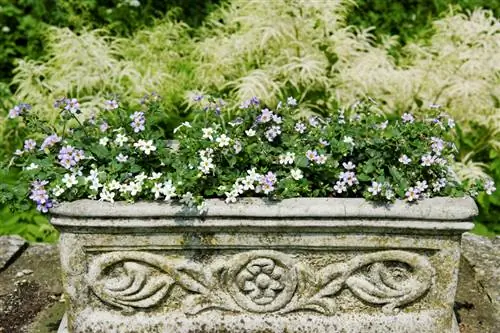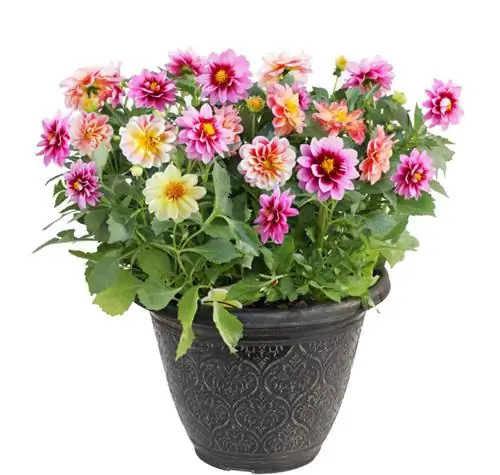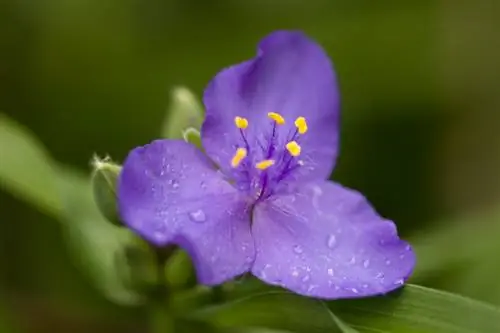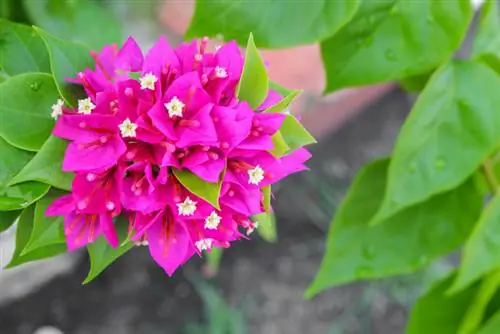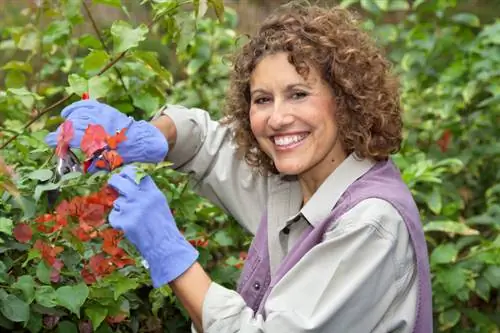- Author admin [email protected].
- Public 2023-12-25 17:45.
- Last modified 2025-01-23 11:20.
The snowflake flower presents itself on the summer balcony as if its flowers had fallen from the sky in flakes. Its gracefully hanging tendrils, strewn with star blossoms, create a picturesque appearance in the hanging basket and flower box. In order for the South African flower beauty to unfold in all its splendor, professional care is important. The following answers to frequently asked questions show you how to do it right.
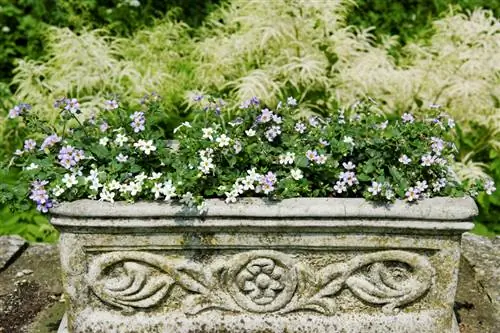
How do I properly care for a snowflake flower?
The snowflake flower requires a sunny to partially shaded location, constantly slightly moist substrate, regular watering with soft water and liquid fertilizer every 14 days. Withered flowers fall off on their own; they are cut back before being moved to winter quarters.
Planting snowflake flowers correctly
So that the snowflake flower can start its blossom festival on time in May, plant the flower in the designated balcony container from mid-April. Before you fill in the potting soil, put clay shards over the water drain to ensure that no waterlogging occurs. Place the young Bacopa only as deep in the soil as before in the cultivation pot and water with soft water. Until mid-May, the exotic grace stays on the sunny balcony during the day and spends the nights indoors. This hardening benefits the vitality and abundance of flowers.
Care tips
The grateful snowflake flower is satisfied with the following care program:
- Keep the substrate constantly slightly moist with soft water
- Ideally let the water run through a funnel to the roots
- Fertilize liquidly every 14 days from May to September
- Cleaning is not necessary
Don't worry when the summer blossom show comes to an end in autumn. Although a Bacopa is not hardy, it still has the vitality to be cultivated for several years. Cut the flower back vigorously and move it to a bright, frost-free winter quarters. At temperatures of 5-8 degrees Celsius, water every now and then without applying fertilizer (€9.00 on Amazon).
Which location is suitable?
The snowflake flower feels comfortable in a sunny to partially shaded, warm location. Of course, the exotic flower does not like the blazing midday sun. So look for a sheltered spot on the west or east side of the house. Incidentally, a summer rain shower does not affect the weather-resistant Bacopa, as is the case with other sensitive balcony plants.read more
The correct planting distance
When you look at a young Sutera cordata, you can't immediately see the opulent volume the plant develops. With a planting distance of 20 cm, you give a snowflake flower enough space to develop in all its blooming splendor in a flower box or large pot.
What soil does the plant need?
The uncomplicated character of a snowflake flower is expressed not least in terms of substrate. Use a commercially available compost-based potting soil with as little peat as possible. So that the summer flower does not suffer from waterlogging, add a few handfuls of lava granules or perlite breathing flakes.
When is flowering time?
With a bloom period from May to October, the snowflake flower outperforms the vast majority of summer perennials. If it has a balanced water and nutrient balance during this time, no further measures need to be taken. A Bacopa gets rid of wilted flowers automatically, so you can save yourself the hassle of cleaning them out.
Cut snowflake flowers correctly
The less a snowflake flower is disturbed, the more impressive its blooms will be. Therefore, only cut back the long shoots if it is absolutely necessary. Shorten the plant heavily only shortly before moving it to its winter quarters.
Watering snowflake flower
Proper regulation of the water balance largely determines the successful course of cultivation. How to water the snowflake flower correctly:
- Keep the substrate constantly slightly moist without causing waterlogging
- If the earth dries out, the flower will die
- Only water when the surface has dried to a depth of 1 cm
- Water preferably with lime-free water
The sunnier the location, the higher the watering requirement. During hot summer days, you may need to water early in the morning and again in the evening. To ensure that the water gets through the dense flower shoots to the roots, simply use a funnel.
Fertilize snowflake flowers properly
In terms of nutrient requirements, the snowflake flower is undemanding. If you administer a liquid fertilizer every 14 days from May to September, this point is fully covered in the care program.
Pests
Aphids have no qualms about attacking a snowflake flower. Therefore, check the undersides of the leaves regularly to see whether the pests have settled there. At the first signs of an infestation, take action against the beasts with the classic soft soap solution. To do this, mix 1 liter of lime-free water with 15 milliliters of soft soap and a few splashes of spirit. Spray the plagued Bacopa every 2-3 days until the plague ends.
Wintering
In its South African homeland, the snowflake flower thrives perennially. The only obstacle to achieving this masterpiece in our regions is the freezing winter temperatures. So that the Bacopa will beautify your balcony again next summer, overwinter the flower like this:
- When autumn temperatures fall below 10 degrees Celsius, cut the plant back heavily
- Put in a bright winter quarters with temperatures between 5 and 8 degrees Celsius
- Water less and don’t fertilize
In spring, repot your floral winter guest into fresh substrate. As soon as there is no longer any fear of ground frost and the mercury column exceeds 10 degrees, the Sutera cordata moves to the balcony.
Propagate snowflake flowers
Cut 5-8 cm long non-flowering head cuttings in July or August. Remove the lower leaves and place two thirds of the shoots in a pot with lean substrate. Moisten the soil regularly with soft water at room temperature. A transparent hood creates a warm, humid microclimate around the cuttings, which encourages rooting. If new leaves sprout, the process is proceeding as planned and the cover can be removed. Throughout the winter, place your pupils in a bright window seat at a cool 5-8 degrees Celsius.
Is snowflake flower poisonous?
Nothing is known about intolerance to snowflake flowers. You can therefore plant the pretty summer flower in your family home without hesitation. Intentional or unintentional consumption of flowers and leaves does not have any harmful effects on the he alth of humans or animals.
Beautiful varieties
- Big Baja: A rich-flowered snowflake flower with tendrils up to 120 cm long, dotted with white starry flowers
- Scopia Double: The premium variety stands out impressively with lush, double, light blue flowers
- Pink Beauty: A rarity among snowflake flowers with light pink flowers adorned by a dark pink throat
- Big Pearl Falls: This Sutera cordata adorns the hanging basket with a waterfall of pink star blossoms
- Scopia Violet: The purple flowers contrast wonderfully with the white and pink Bacopa varieties

